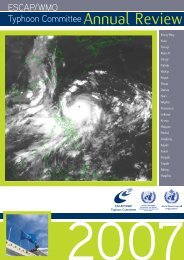TCAR - Typhoon Committee
TCAR - Typhoon Committee
TCAR - Typhoon Committee
You also want an ePaper? Increase the reach of your titles
YUMPU automatically turns print PDFs into web optimized ePapers that Google loves.
100<br />
ESCAP/WMO<br />
<strong>Typhoon</strong> <strong>Committee</strong> Annual Review 2009<br />
Resources Corporation) measuring stations;<br />
· AWS information and 3-hour weather information<br />
from KMA (Korea Meteorological Administration)<br />
- GIS-based integrated measurement information<br />
system<br />
· CCTVs are classified according to their use and<br />
grouped by region or specific disasters on GIS<br />
maps;<br />
· Information including CCTV images are displayed<br />
according to specific parameters—view of the<br />
river, typhoon trajectory, selected region(s), etc.;<br />
· CCTV images are displayed with a warning<br />
when disasters occur.<br />
The National Institute for Disaster Prevention<br />
(NIDP) developed an automatic damage detecting<br />
system for disaster management, which detects<br />
damage by comparing before and after images<br />
of a given site and issues warnings to decisionmakers.<br />
For example, color changes in a specific<br />
area may indicate a wild fire, while geological<br />
information helps identify landslides, and water<br />
surface elevation over the warning line indicates<br />
flooding. The system may also help decisionmaking<br />
for managing extreme events on a local<br />
scale.<br />
Fig. 20. Related organizations information system<br />
Development of decision-making system for<br />
disaster response or management<br />
NEMA established a decision-making system<br />
to effectively respond to expected extreme<br />
events based on analyzed results from<br />
monitoring, modeling, and statistical analysis<br />
of meteorological elements and rainfall runoff.<br />
The system facilitates accurate and fast analysis<br />
by flagging areas vulnerable to flooding and<br />
landslides, displaying all the relevant information<br />
on GIS maps for decision-makers. The system<br />
is equipped with the following decision-making<br />
16<br />
support functions using GIS-based observational<br />
information:<br />
- Link of the observational information<br />
· The system links water surface elevation,<br />
rainfall, snow depth, and CCTV data collected by<br />
related organizations.<br />
- Decision-making support<br />
· Function for analyzing disaster-related<br />
information with information on consequences<br />
and damage;<br />
· Establishment of warning and notification<br />
system to communicate disaster information<br />
and development of countermeasures based on<br />
collected information;<br />
· Reference function for watershed or<br />
administrative information;<br />
· Function for decision-making to reduce<br />
inundation damage with inundation maps<br />
developed using inundation data from 1995 to<br />
2007;<br />
· Distributed rainfall runoff model to represent<br />
expected inundation areas using expected<br />
rainfall data.<br />
Fig. 21. Decision-making system main page<br />
Fig.22. MAPLE data analysis system

















